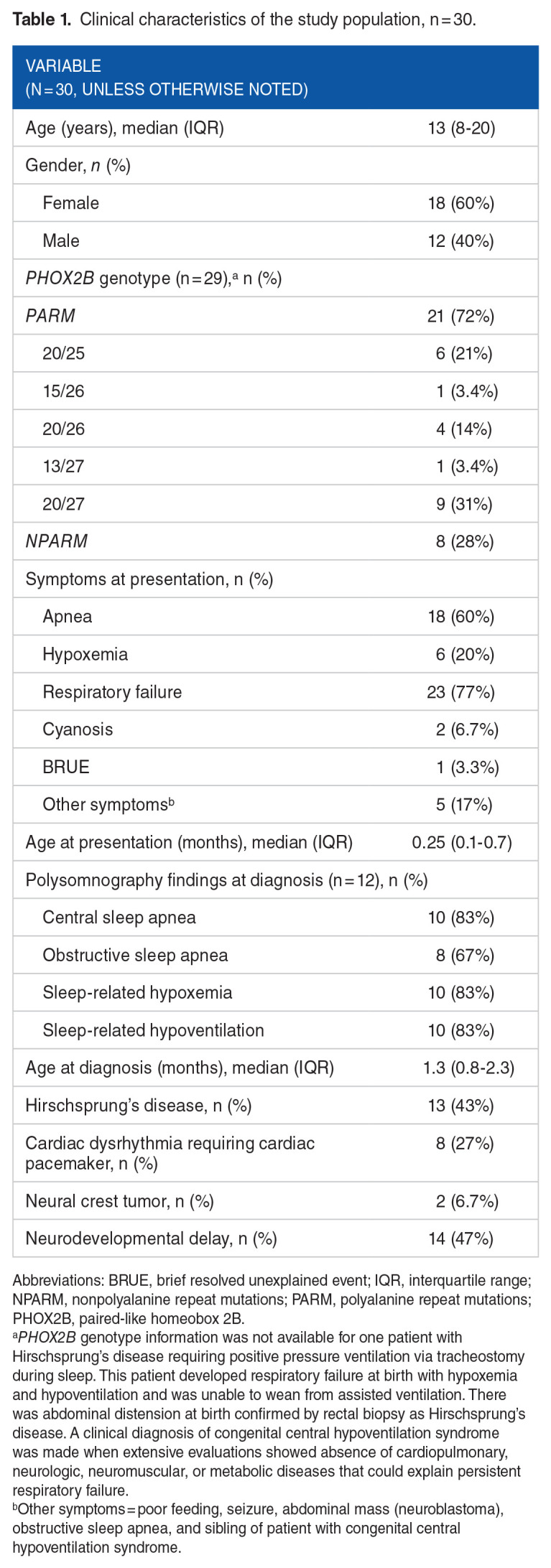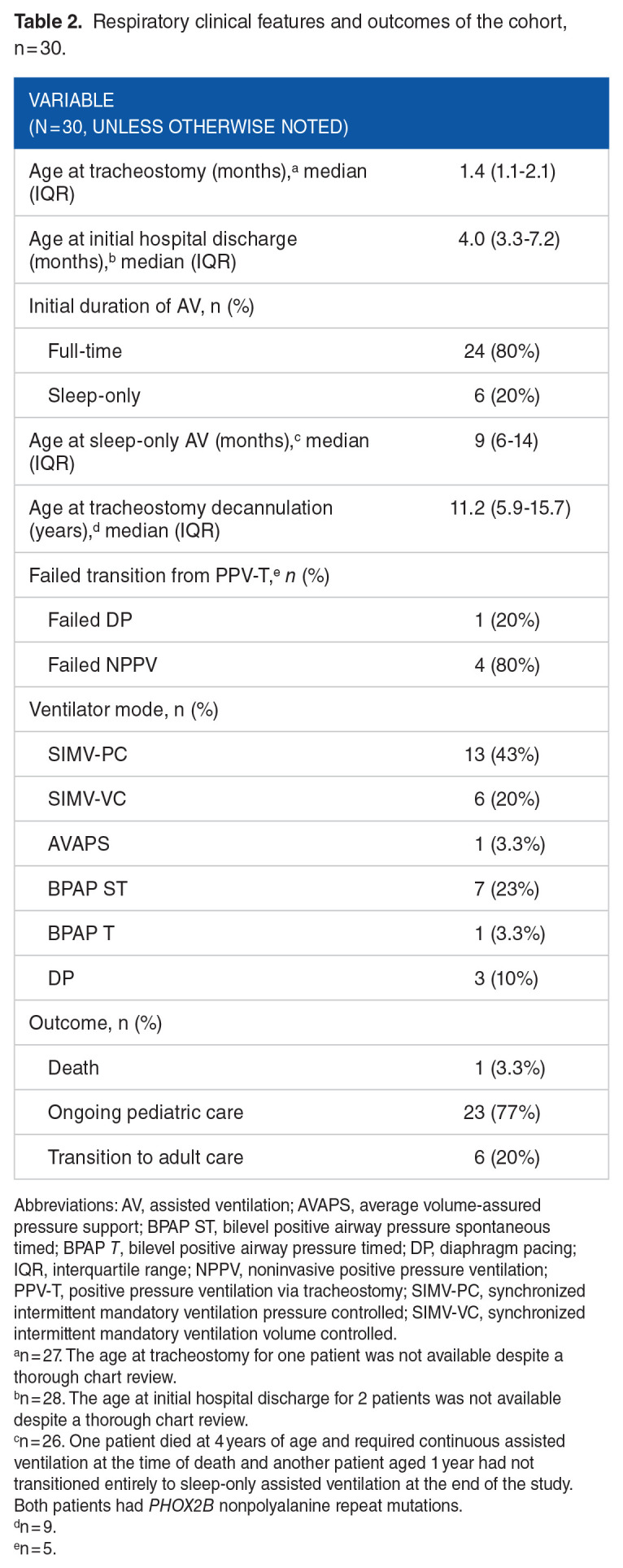Congenital Central Hypoventilation Syndrome: Diagnosis and Long-Term Ventilatory Outcomes.
IF 1.2
Q2 PEDIATRICS
引用次数: 1
Abstract
Background: Congenital central hypoventilation syndrome (CCHS), a rare disease caused by variants in the paired-like homeobox 2B (PHOX2B) gene, affects regulation of respiration necessitating lifelong assisted ventilation (AV). Most patients require full-time AV during infancy and some patients may sustain adequate spontaneous ventilation during wakefulness and change AV modalities at a later age. The aims of this study were to assess the changes in duration and modalities of AV, long-term respiratory outcomes, and to correlate them with PHOX2B genotypes. Methods: We conducted a retrospective study of patients with CCHS treated at our institution between January 1997 and May 2022. Results analyzed included: clinical presentation, PHOX2B genotype, modality and duration of AV at diagnosis and follow-up, survival, and transition to adult care. Results: We identified 30 patients with CCHS—8 with PHOX2B nonpolyalanine repeat mutations (NPARMs), 21 with polyalanine repeat mutations (PARMs), and 1 with unknown PHOX2B genotype. The median age at presentation was 0.25 months (IQR 0.1-0.7 months). At diagnosis of CCHS, 24 (80%) patients required continuous AV and 28 (93%) received AV via tracheostomy. Twenty-six patients required sleep-only AV at a median age of 9 months (IQR 6-14 months). Nine patients requiring sleep-only AV underwent tracheostomy decannulation at a median age of 11.2 years (IQR 5.9-15.7 years) and used noninvasive positive pressure ventilation or diaphragm pacing. There was insufficient evidence to conclude that patients with PARMs and NPARMs differed by age at presentation (P = .39), tracheostomy (P = .06), and transition to sleep-only AV (P = .9). Six patients transitioned to adult care, 23 continued receiving pediatric care, and 1 patient died due to complications from Hirschsprung’s disease. Conclusion: Our study demonstrates prolonged survival and good long-term respiratory outcomes possibly related to the early diagnosis of CCHS, optimizing AV strategies, and multidisciplinary care. The increasing number of patients attaining adulthood highlights the necessity for multidisciplinary care for adults with CCHS.



先天性中枢性低通气综合征:诊断和长期通气结局。
背景:先天性中枢性低通气综合征(CCHS)是一种由配对样同源盒2B (PHOX2B)基因变异引起的罕见疾病,影响呼吸调节,需要终身辅助通气(AV)。大多数患者在婴儿期需要全职的房室通气,一些患者在清醒时可以维持足够的自发通气,并在以后的年龄改变房室通气方式。本研究的目的是评估AV持续时间和模式的变化,长期呼吸结果,并将其与PHOX2B基因型联系起来。方法:我们对1997年1月至2022年5月在我院治疗的CCHS患者进行了回顾性研究。结果分析包括:临床表现,PHOX2B基因型,AV诊断和随访时的模式和持续时间,生存和向成人护理的过渡。结果:30例CCHS-8患者存在PHOX2B非多丙氨酸重复突变(NPARMs), 21例存在多丙氨酸重复突变(PARMs), 1例PHOX2B基因型未知。就诊时的中位年龄为0.25个月(IQR为0.1-0.7个月)。诊断为CCHS时,24例(80%)患者需要持续房颤,28例(93%)患者通过气管造口术接受房颤。26例患者中位年龄为9个月(IQR 6-14个月)时需要进行睡眠性房颤。9例仅需要睡眠的房颤患者在平均年龄11.2岁(IQR 5.9-15.7岁)时接受了气管造口脱管术,并使用无创正压通气或隔膜起搏。没有足够的证据表明parm和nparm患者在发病年龄(P = 0.39)、气管造口术(P = 0.06)和过渡到仅睡眠AV (P = 0.9)方面存在差异。6名患者转为成人护理,23名患者继续接受儿科护理,1名患者死于先天性巨结肠病的并发症。结论:我们的研究表明,延长生存期和良好的长期呼吸预后可能与CCHS的早期诊断、优化AV策略和多学科护理有关。越来越多的成年患者强调了对成年CCHS患者进行多学科护理的必要性。
本文章由计算机程序翻译,如有差异,请以英文原文为准。
求助全文
约1分钟内获得全文
求助全文

 求助内容:
求助内容: 应助结果提醒方式:
应助结果提醒方式:


